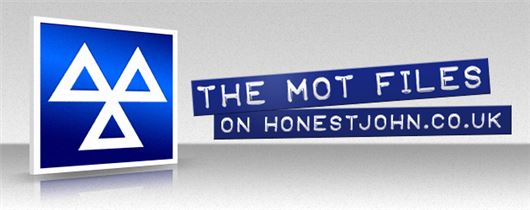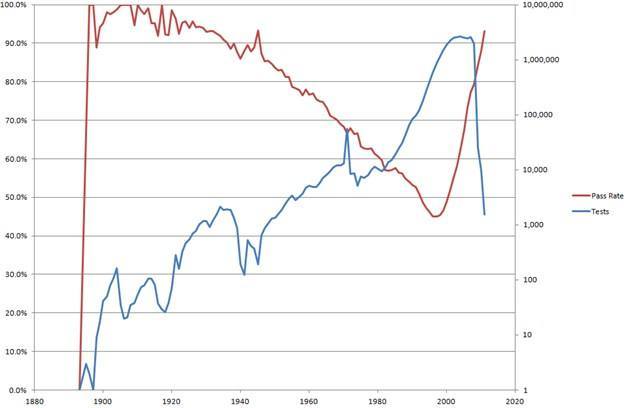The MoT Files: Exemption for pre-1960s cars. Do the numbers stack up?

The Government has announced plans to make cars registered before 1960 exempt from the annual MoT test. There's been much debate over whether this proposal is a good idea. Some say that these cars are well cared-for classics and by default are roadworthy, others claim it will allow unrestored and unroadworthy cars onto the road without any checks.
The Government's own data on the subject is largely anecdotal, with Mike Penning, the Roads Minister saying owners of classic cars are: "Out there in all weathers checking the condition of the engine, tyres and bodywork".
So we once again raided the MoT Files to see whether the numbers stack up. These figures are for MoTs conducted between October 2010 and September 2011 ND show that it is something that the Government could - on paper at least - justify. There were 55,000 MoTs for cars registered before 1960 in the data we have (out of 24.5m MoT tests) and the overall pass rate for all the years combined was 85.2 per cent.
The pass rate for each year before 1954 is better than the pass rate for 2008 cars in their first test, and the overall pass rate for pre-1960 cars was 85 per cent, better than the 80 per cent for 2008. Looking at it this way, the argument for keeping the test on pre-1960 cars seems about as strong as that for introducing the test on two year old cars.
But - and this is a big one - is that you could argue that without the MoT test there could be almost 10,000 unroadworthy cars on the road. The big danger is that no one will know once the cars are exempt and there's a chance that cars that have been previously SORNed as they'd fail an MoT will now be back on the road - and no one will know if they're roadworthy or not.
| Year of Registration | Number of MoT Tests | MoT Pass Rate | Number of Failures |
| 1893 | 1 | 0.0% | 1 |
| 1895 | 3 | 66.7% | 1 |
| 1896 | 2 | 100.0% | 0 |
| 1897 | 1 | 100.0% | 0 |
| 1898 | 9 | 88.9% | 1 |
| 1899 | 17 | 94.1% | 1 |
| 1900 | 41 | 95.1% | 2 |
| 1901 | 50 | 98.0% | 1 |
| 1902 | 79 | 97.5% | 2 |
| 1903 | 107 | 98.1% | 2 |
| 1904 | 165 | 98.8% | 2 |
| 1905 | 34 | 100.0% | 0 |
| 1906 | 20 | 100.0% | 0 |
| 1907 | 21 | 100.0% | 0 |
| 1908 | 35 | 100.0% | 0 |
| 1909 | 38 | 94.7% | 2 |
| 1910 | 55 | 100.0% | 0 |
| 1911 | 74 | 98.6% | 1 |
| 1912 | 80 | 97.5% | 2 |
| 1913 | 104 | 99.0% | 1 |
| 1914 | 105 | 95.2% | 5 |
| 1915 | 82 | 95.1% | 4 |
| 1916 | 37 | 91.9% | 3 |
| 1917 | 29 | 100.0% | 0 |
| 1918 | 26 | 92.3% | 2 |
| 1919 | 38 | 92.1% | 3 |
| 1920 | 72 | 98.6% | 1 |
| 1921 | 279 | 96.4% | 10 |
| 1922 | 159 | 92.5% | 12 |
| 1923 | 322 | 95.3% | 15 |
| 1924 | 455 | 95.6% | 20 |
| 1925 | 537 | 94.0% | 32 |
| 1926 | 689 | 95.6% | 30 |
| 1927 | 769 | 94.1% | 45 |
| 1928 | 1032 | 94.4% | 58 |
| 1929 | 1158 | 94.0% | 70 |
| 1930 | 1177 | 93.0% | 82 |
| 1931 | 915 | 93.1% | 63 |
| 1932 | 1219 | 93.1% | 84 |
| 1933 | 1578 | 92.4% | 120 |
| 1934 | 2151 | 92.0% | 173 |
| 1935 | 1886 | 91.0% | 170 |
| 1936 | 1919 | 90.3% | 186 |
| 1937 | 1881 | 88.6% | 215 |
| 1938 | 1343 | 89.9% | 135 |
| 1939 | 877 | 87.7% | 108 |
| 1940 | 193 | 86.0% | 27 |
| 1941 | 125 | 88.0% | 15 |
| 1942 | 531 | 89.6% | 55 |
| 1943 | 411 | 87.8% | 50 |
| 1944 | 371 | 88.9% | 41 |
| 1945 | 192 | 93.2% | 13 |
| 1946 | 634 | 87.4% | 80 |
| 1947 | 864 | 85.3% | 127 |
| 1948 | 1042 | 85.4% | 152 |
| 1949 | 1318 | 84.7% | 202 |
| 1950 | 1352 | 83.6% | 222 |
| 1951 | 1592 | 82.9% | 273 |
| 1952 | 1879 | 83.1% | 318 |
| 1953 | 2461 | 81.3% | 461 |
| 1954 | 2976 | 81.3% | 557 |
| 1955 | 3416 | 78.7% | 726 |
| 1956 | 2846 | 78.3% | 617 |
| 1957 | 3211 | 77.9% | 711 |
| 1958 | 3735 | 76.5% | 877 |
| 1959 | 4691 | 77.9% | 1035 |
| 1960 | 5160 | 76.6% | 1206 |

Comments
Compare classic car insurance quotes and buy online. A friendly service offering access to a range of policies and benefits.



 Dan Harrison
Dan Harrison
 NEC classic motor show 2020 postponed due to Covid 19 concerns
NEC classic motor show 2020 postponed due to Covid 19 concerns
 Classic car auction house Coys goes into administration
Classic car auction house Coys goes into administration
 Motor racing great Sir Stirling Moss dies aged 90
Motor racing great Sir Stirling Moss dies aged 90
 Alfa Romeo anniversary races set for Silverstone
Alfa Romeo anniversary races set for Silverstone
 Government to make E5 fuel available for classic owners
Government to make E5 fuel available for classic owners
 Plans to introduce cleaner fuel could damage more than a million classic cars
Plans to introduce cleaner fuel could damage more than a million classic cars
 Top 10: Classic cars from the Gulf motor racing heritage collection
Top 10: Classic cars from the Gulf motor racing heritage collection











hamish on 6 June 2013
somedy can pull a dangerous car out a barn tax it sell it avoid all restoration costs imagine a three tonne caddilac no brakes power steering new paint job someones paid 18000 its a arther daley dream
Add a comment